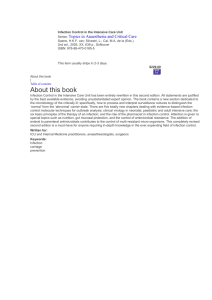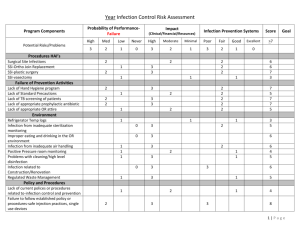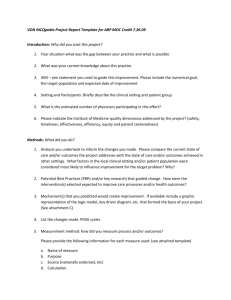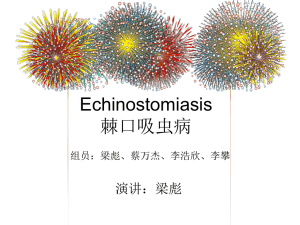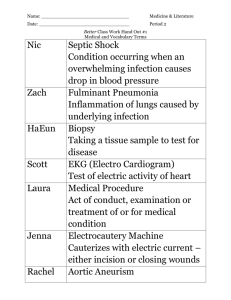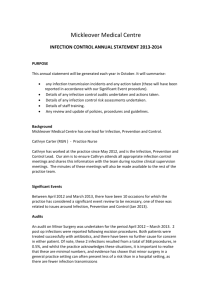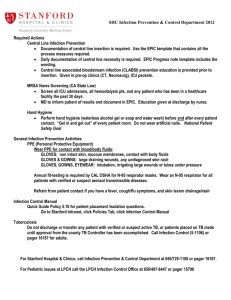research proposal
advertisement
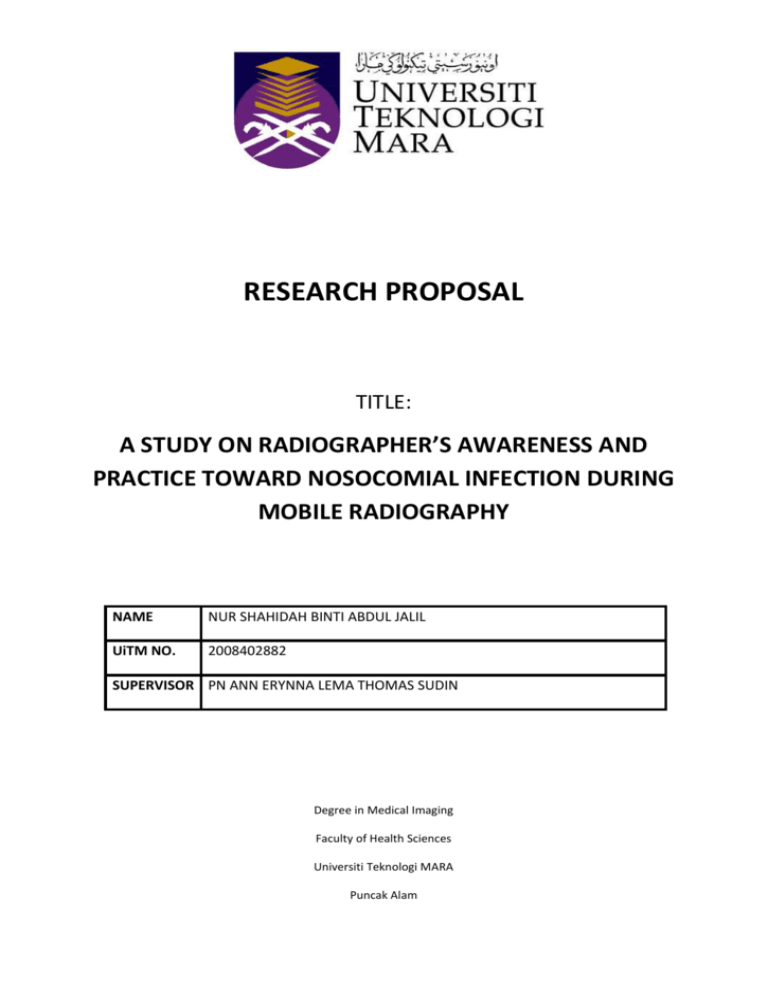
RESEARCH PROPOSAL TITLE: A STUDY ON RADIOGRAPHER’S AWARENESS AND PRACTICE TOWARD NOSOCOMIAL INFECTION DURING MOBILE RADIOGRAPHY NAME NUR SHAHIDAH BINTI ABDUL JALIL UiTM NO. 2008402882 SUPERVISOR PN ANN ERYNNA LEMA THOMAS SUDIN Degree in Medical Imaging Faculty of Health Sciences Universiti Teknologi MARA Puncak Alam LITERATURE REVIEW The nosocomial infection is some of the infection that occurs in the hospital. According to Ochie, et al. (2009) and Lim, et al. (2008) nosocomial infection is the infection that occurs after 48 hours patient admit to the hospital. The nosocomial infection also can be describe as the disease that patient have after 30 days patients discharge from hospital. Patient that having nosocomial infection can be category as the patient that has disease that he or she not has before admitted to the hospital. The term nosocomial infection can be describes as hospital acquired infection, (Fox, et al., 2008). Futhermore, when the infection had been infected by healthcare workers the term change to occupationally acquired. (Ehrlich, et al., 2009). Based on Horan, et al. (2008) the infection can be categories as urinary tract infection (UTI), surgical site infection, bloodstream infection, pneumonia, gastrointestinal (GI) system infection, lower respiratory tract infection that are other than pneumonia, reproductive tract infection, skin and soft tissue infection, bone and joint infection central nervous infection, cardiovascular system infection and systemic infection. According to Ochie, et al. (2009) the most common infection is UTI. Radiology department may have a role to diagnosis the patient. For that, the radiology department receive a lot of patients whether outpatient or in patient. (Ochie, et al., 2009 and Tugwell, et al., 2011). We can conclude that radiology department have high risk to spread the diseases from patient to staff, staff to staff, patient to patient, equipment to patient and staff and vice versa. According Ochie, et al. (2009) some of the equipment that can contribute to spread the disease or pathogens are x-ray couches, chest stands, control panel, exposure buttons, cassette that has been used while mobile radiography and patient gowns. Based on Fox, et al. (2008) cassette x-ray is the possible equipment that can be source of the nosocomial infection. However Ochie, et al. (2009) were found a lot of common bacteria in the cassette that has been used while performing mobile radiography. Bacteria that have been found were Coagulase negative staphylococcus, micrococci, diphtheriods and some of the species of bacillus. As we know, cassette is the equipment that always direct contact with patient skin, so from that we can conclude that cassette is one of the most equipment that can be the source of nosocomial. Ochie, et al. (2009) they were found a lot of bacteria such as staphylococcus aureus, pseudomonas aeruginosa, klebsiellaspp , enterococcus spp, citrobacterspp, acinobacterspp, yersinaenterolitica, treponema palladium, mycobacterium tuberculosis, coagulase-negative staphylococci (epidermidis and saprophyticus) and coliform spp. Klebsiellaspp is the most bacteria found in radiographers’ hand. Furthermore, coliform spp can be related to medical staff’s hands and also can be associated with equipment. In this journal also, they stated that bacteria can enter by open route and wound. So, all medical staff and patient should be aware about this. Based on Fox, et al. (2008) nosocomial infection has been investigated while doing mobile radiography. Some of the bacteria have been found were Escherichia coli, Enterococcus faecalisand Staphylococcus aureus. Bacteria can grow inanimate things such as x-ray cassette. In this study also said that, there were no approve that cassette can cause nosocomial infection but cassette was the things that pathogen grow, so it can contribute to nosocomial infection. While we are focusing only to x-ray cassette, x-ray couch and all big equipment, we are forget about small object like radiographic marker. All radiographers have their own radiographic marker but in the study by Tugwell, et al. (2011) said that rare of the radiographers wash or clean their radiographic marker. Radiographic marker has been used in all examination. All the bacteria will be transmitting to radiographer hand and radiographer will be contact with patient. It will decrease the effectiveness of performing hand hygiene and then it will be increasing the nosocomial infection. Study has been done by Okaro, et al. (2010) reported that body fluid also can be one of the factors of nososcomial infection if radiographer not aware about this infection. Okaro, et al. (2010) also reported that recapping needle after using it was very command. So, if that procedure is apply in all time, maybe some of radiographer will injured by that needle. It was very dangerous because open wound is one of the routes of nosocomial infection. It will increase infection among radiographers. In this research reported that only 41.7% of radiographers apply the principle of universal precaution. It is not achieve half of the practitioner, so we have to worry with this situation Most of radiographers only clean their equipments such as cassette and couch after treat patients with open wounds. In this research also reported that most of radiographers also only clean their hands after treat the some conditions of the patients. (Okaro, et al., 2010). Research conducted by Tan, el al. (2005) was focusing in patient having tuberculosis (TB). TB can be spread if health workers not alert about infection control. Some of radiographers not wearing the mask while examine patient with this condition. It can infect to radiographers and it will transmit to other patient if the radiographer not aware. It is because to confirm that the patient have TB, that patient have to come to check their chest, so from that we know that radiographer is the high tendency to get TB and spread to other patient if they not aware about nosocomial infection. There are a lot of effects if health workers not alert about infection control. Fox, et al. (2008) found that more than 100000 people get nosocomial infection. The London School of Hygiene Survey reported those patients that have nosocomial infection admitted to the hospital 11 days longer. It will cause the cost of treatment increases. (Fox, et al., 2008). Some of the reasons why they do not perform precaution procedure is they do not have enough education. In journal reported by Saleh, et al. (2009) study in Egypt has been done ad they found 24022 health care workers get infection hepatitis C virus (HCV) and 8617 hepatitis B virus (HBV). However, this studies only done within nurses, laboratory technician and housekeeper. Most of them received one time education about precaution education. We can conclude that they receive less education. One time education is not very necessary. In this study, the health education intervention is effective. Level of knowledge in laboratory technician is higher than nurses but the practice is lower than the nurses. (Saleh, et al., 2009). Others reasons reported by Saleh, et al. (2009) they were lack of the equipment to prevent nosocomial infection such as gloves and safety boxes needle disposal, work overload and lacking of training to perform precaution procedures. Okaro, et al. (2010) also agreed that not only knowledge can prevent the nosocomial infection but the training and adequate skill of radiographer to prevent nosocomial infection was also the important things. They also said the reason why radiographer to having adequate skill was radiographer has high tendencies to spread the pathogen that can cause nosocomial infection. To prevent nosocomial infection to be spread out, there are some precautions that radiographers have to follow. In journal reported by Onifade, et al. (2007) 20, they were focused on sharp policy that has been used at Lagos University Teaching Hospital, Nigeria. They said that policy was to prevent transmission of pathogen among patient and health workers. This studies also said that the level of knowledge of ‘sharps’ among patient and health workers were high but the knowledge about sharp policy was not very good. The sharp policy was important to know because it can reduce sharp injuries. Furthermore, it will reduce the nosocomial infection because sharp injuries can be the factor of nosocomial infection. Other than that, they were focused on hand washing technique. The most effective method to prevent nosocomial infection was performing right hand washing technique. (Patakarul, et al., 2008). They also said that hand washing was very crucial and less expensive to be done among patient, health workers and visitor. Based on research were done by Patakarul, et al. (2008) and Gould, et al. (2008) their studies were focused at intensive care unit (ICU) and cardiac care unit (CCU). Patakarul, et al. (2008) reported that, none of the radiographer performing hand washing technique while doing examination on patient at ICU and CCU. In their studies also they were included visitor as the subject because visitor also can be source of nososcomial infection. Performing of hand hygiene was low among the visitor. (Patakarul, et al., 2008). Furthermore, to prevent nosocomial infection was using alcohol hand rub. This method was very easy and less time needed to perform it. (Patakarul, et al., 2008). After performing alcohol hand rub, they are not recommended to perform hand washing technique because it can cause dermatitis. In their studies, they also include the reasons why health workers, patient and visitor not performing hand hygiene. The reasons were they were forgetful and lacking of knowledge. To clean equipment, Ochie, et al. (2009) were suggests to use some chemical disinfectant agents such as chloroxylenol, dichloroxyleenol, sodium hypochlorite and methylated spirit. The most effective chemical disinfectant agent was sodium hypochlorite. But some of the practitioner, they were just using water to clean the equipments and hands. OBJECTIVES General Objectives : 1. To study radiographer’s awareness and practise toward nosocomial infection during mobile radiography. Specific Objectives : 1. To determine the awareness stage among radiographers toward nosocomial infection during mobile radiography. 2. To investigate correlation between awareness and practise among radiographers during towards nosocomial infection during mobile radiography. 3. To investigate the method has been used by radiographers to prevent nosocomial infection during mobile radiography. HYPOTHESIS 1st Objective: Null hypothesis (NO): The awareness stage among radiographers towards nosocomial infection during mobile radiography is low. Alternative hypothesis (Na): The awareness stage among radiographers towards nosocomial infection during mobile radiography is high. 2nd Objective: Null hypothesis (NO): There is no correlation between awareness and practice among radiographers towards nosocomial infection during mobile radiography. Alternative hypothesis (Na): There is correlation between awareness and practice among radiographers towards nosocomial infection during mobile radiography. 3rd Objective: Null hypothesis (NO): Radiographers using water only to prevent nosocomial infection during mobile radiography. Alternative hypothesis (Na): Radiographers using a lot of method to prevent nosocomial infection during mobile radiography. METHODOLOGY Study Design Prospective study. Study Location This project will be done mainly at Hospital Tuanku Jaafar Seremban, Negeri Sembilan. Sample Size For this study, at least 30 radiographers will be selected. The inclusion criteria for this study is radiographers that perform mobile radiography. Otherwise, the exclusion criteria are radiographers that not perform mobile radiography. Age and working experience in this study not included. Data Collection The data will be collected using questionnaire. This questionnaire has four (4) parts. Part A will be personal information. Part B will be questions for assessing stage of awareness and for part C will be assessing practice of radiographer toward nosocomial infection during mobile radiography. The last part will be assessing the method had been used by radiographers to prevent nosocomial infection. The data that has been collected will be transfer in Microsoft Excel and will be calculate and analyse using SPSS 14.0 for windows. For awareness, practice and method that radiographers used, frequencies with means and standard deviation will be computed. For the correlation of awareness and attitude, I will use T-test. REFERENCES Ehrlich, R. A., & Daly, J. A. (2009). Patient care in radiography. Canada: Mosby Elsevier. Fox, M. & Harvey, J. M. (2008). An investigation of infection control x-ray cassette in a diagnostic imaging department. The College of Radiographers, 14, 306-311. doi:10.1016/j.radi.2007.09.004. Gould, D. J., Drey, N. S., Moralejo, D., Grimshaw, J., & Chuleigh, J. (2008). Interventions to improve hand hygiene compliance in patient care. Journal of Hospital Infection, 68, 193202. Horan, C. T., Andrus, M., & Dudeck, M. A. (2008). CDC/NHSN surveillamce definition of health care-associated infection and criteria for specific types of infections in the acute care setting. Am Journal Infect Control, 36, 309-332. Lim, W. S., Natesan, S., Lim, Y. P., & Tan, T. L. (2008). Nosocomial infection in the elderly: Time for review of the definition?. Asian journal Gerontol Geriatr, 3, 92-94. Ochie, K., & Ohagwu, C. C. (2009). Contamination of x-ray equipment and accessories with nosocomial bacteria and the effectiveness of common disinfecting agents. African Journal of Basic & Applied Sciences 1, 1 (1-2), 31-35. Okaro, A. O., Eze, C. U., & Ohagwu, C. C. (2011). Awareness, knowledge, attitude and practice of blood and body fluid precautions among radiographers in Enugu, Nigeria. African Journal of Basic & Applied Sciences 2, 1-2, 11-17. Onifade, K. A. U., & Odeyemi, K. A. (2007). ‘Sharps’ and sharps policies; Knowledge of health workers at the Lagos University Teaching Hospital, Nigeria. Nigeria Medical Practitioner 52(2), 42-46. Patakarul, K., Tan-Khum, A., & Padungpean, D. (2005). Cross-sectional survey of handhygiene compliance and attitudes of health care workers and visitors in intensive care units at King Chulalongkorn Memorial Hospital. Journal Medical Association Thailand, 88, Suppl.4, 287-293. Saleh, D. A., Elghorory, L. M., & Shafik, M. R. (2009). Improvement of knowledge, attitudes and practices of health care workers towards the transmission of blood-borne pathogens: An intervention study. Journal Egypt Public Health Association, 84, 423-441. Tan, L. H., & Kamarulzaman, A. (2006). Preventing tuberculosis in healthcare workers of the radiology department: A Malaysian perspective. Biomedical Imaging and Intervention Journal, 2(1), 1-3. doi: 10.2349/biij.2.1.e3. Tugwell, J., & Maddison, A. (2011). Radiographic markers – A reservoir for bacteria?. The College of Radiographers, 17, 115-120. doi:10.1016/j.radi.2010.10.005. Comment of Project Management Committee: ___________________________________________________________________________ ___________________________________________________________________________ ___________________________________________________________________________ ___________________________________________________________________________ ___________________________________________________________________________ ___________________________________
